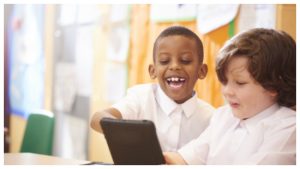Inspiring Girls in STEM Challenge Day at Futures Institute Banbury
The Girls in STEM Day kicked off with a motivating talk from a female ambassador at the...
Read more Inspiring Girls in STEM Challenge Day at Futures Institute Banbury
As tech becomes an increasingly common feature of the classroom, it is naturally being put to use in improving young people’s literacy. This may often take the form of ebooks and improved accessibility but the tech can also be a lot more creative than that, according to the experts.
In this Tes podcast, Melissa Heppell, primary principal at Atlantic Academy Portland, in Dorset, shares some of the more inventive tech approaches that her staff have taken, from using programmable robots to trying on virtual reality headsets and having dinosaurs roaming around the classroom.
The key, she explains, is to ask the right questions in advance of using the technology to ensure that you’re not just buying into “gimmicks”.
“What can I use really successfully and what can enhance things?” she says. “What are your priorities and what do you need to enhance these, and to support it to help teachers along the way?”

Image supplied by TES
There is no shortage of programmes, apps and hardware options out there, Heppell explains, but in the interests of not blowing the entire budget on gadgets, it is crucial to be smart about the choices you make.
“In practice, it’s about whether the teachers can use it, whether the children can engage in it and what the outcomes are,” she says. “There are some great things out there and we use a lot of them, but there are some things that wouldn’t be right for our school and that’s about knowing our children, our school, our community and what works for us.”
She is joined on the podcast, sponsored by reading app Pickatale, by Dr Jennifer Milne, who is a principal teacher at Queen Anne High School in Fife and an associate tutor at the University of Glasgow’s School of Education, where she has been researching reading levels of adolescents during the pandemic.
“What we found in that research was that about a quarter of our young people increased their reading over the pandemic and a quarter decreased, and then we had a group in the middle that didn’t increase or decrease their level of reading,” she explains.
“Those 25 per cent who were not engaging in learning and were decreasing their reading, that’s something that we need to really focus on coming out of the pandemic.”
Listen to the podcast below:
The research also uncovered some interesting trends around reading preferences: around one-third of young people said they preferred reading online books, as became common in lockdown, rather than paper versions.
“I thought that was quite interesting and significant,” Milne says. “And that’s something that we should take forward. A third is a high proportion, so we are working to provide [online books] for them.
“But if there’s still two-thirds of young people who would prefer to hold the book in their hands, we can’t forget that as well. So when we’re using digital approaches, we’re having to go back to the whole idea of interweaving and working these together. Those people that prefer a book can still get advantages from digital approaches and vice versa.”
Heppell adds that when employing any tech, there is a lot to be gained from allowing the skills of young people to come to the fore – particularly when things aren’t going to plan.
“We know how wrong technology can go and there’s nothing worse than standing in front of a class of 30 children relying on something and nothing works,” she says.
“Be confident and have a go, but don’t be scared to ask children to help support you because they know way more than you do. Some of our youngest children have a massive wealth of knowledge, and they will always be happy to come and show it.”
The Girls in STEM Day kicked off with a motivating talk from a female ambassador at the...
Read more Inspiring Girls in STEM Challenge Day at Futures Institute BanburyIn February, five Aspirations Academies were involved in the Year 9 Future Ready Programme, delivered by Speakers...
Read more Year 9 Future Ready Programme LaunchesThe first Aspirations Employability Diploma final of 2025 marked a significant milestone in the academic year, bringing...
Read more AAT Celebrates First Aspirations Employability Diploma Final of 2025